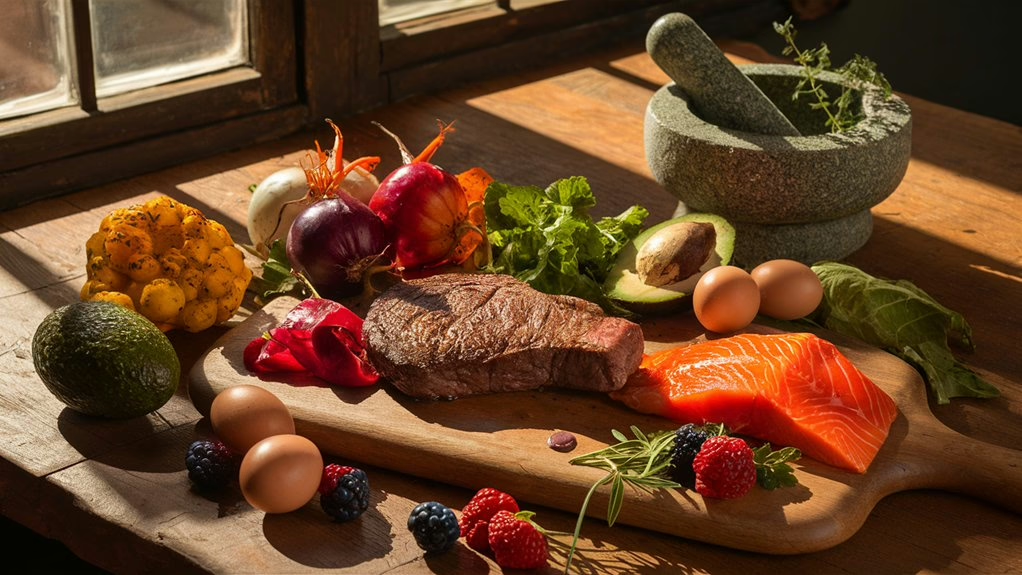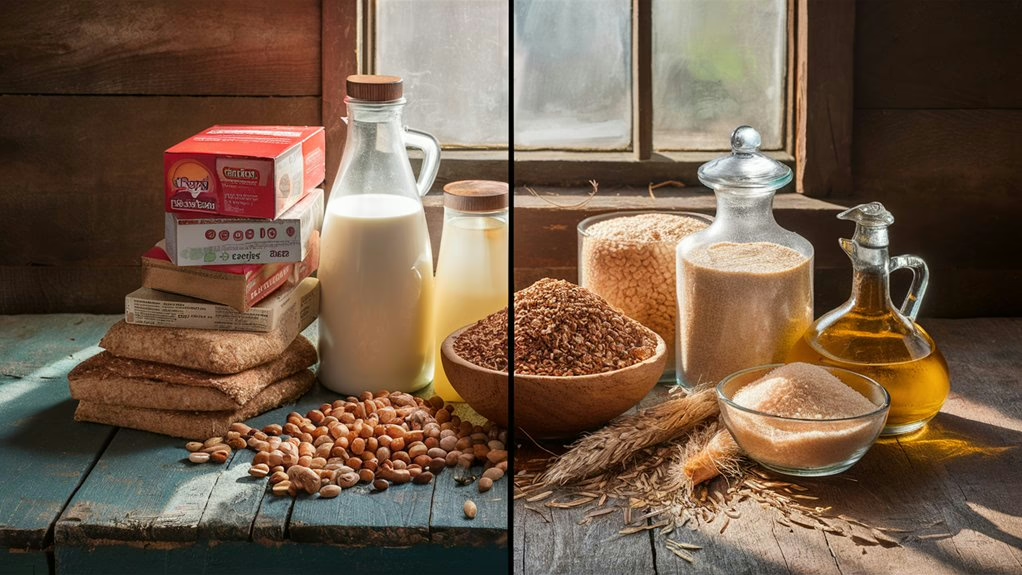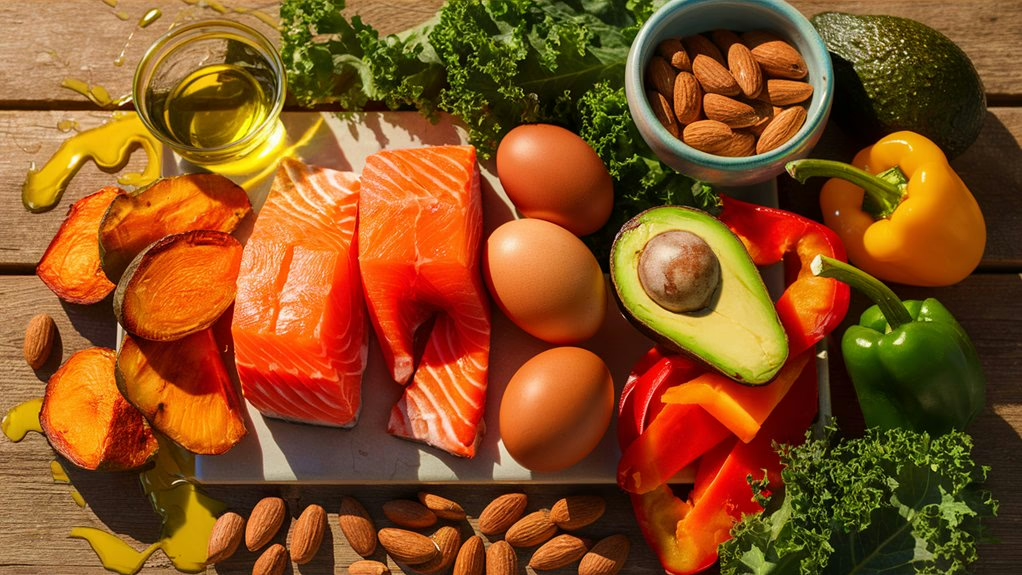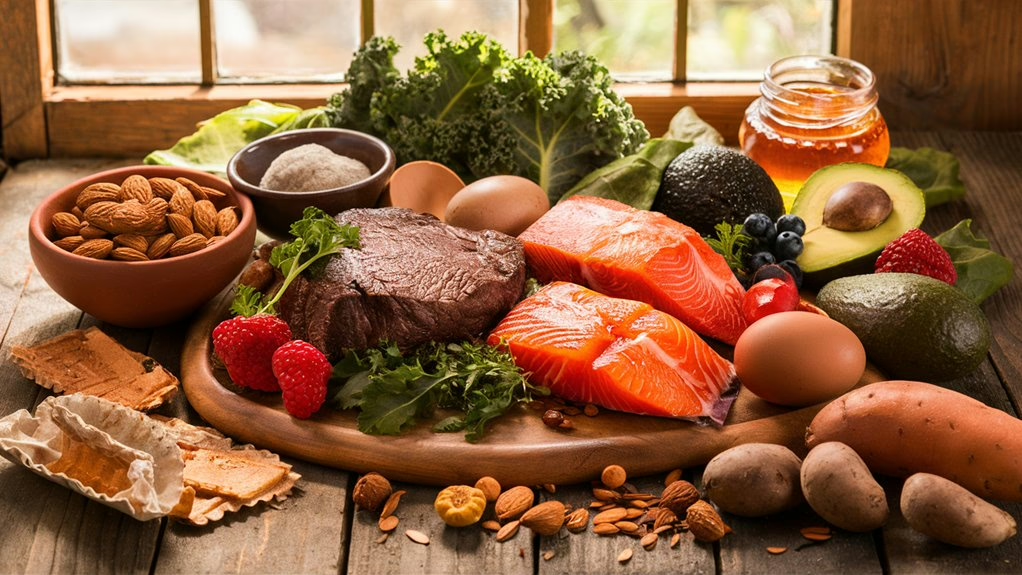The Paleo diet takes you back to basics by mimicking how our ancient ancestors ate during the Paleolithic era. You’ll focus on whole, unprocessed foods like lean meats, fish, fruits, vegetables, nuts, and seeds while eliminating grains, dairy, legumes, and processed foods. This eating approach has shown promising results for weight loss, improved blood sugar control, and reduced inflammation. Getting started involves cleaning out your pantry, stocking up on fresh ingredients, and planning your meals around nutrient-dense foods. While the transition might seem challenging at first, understanding the core principles and benefits will help you embrace this ancestral way of eating.
Understanding Modern Stone Age Eating

A plate piled with lean meats, colorful vegetables, and nuts represents the essence of modern stone age eating. When you follow a paleo diet, you’re embracing a whole foods diet that mirrors what our ancestors ate during the Paleolithic era, though with a modern twist.
You’ll find yourself focusing on unprocessed foods that would’ve been available to hunter-gatherers, while avoiding grains, dairy, and legumes.
The low-carb paleo approach isn’t exactly what our ancestors ate, since today’s foods have evolved significantly through selective breeding. You’re actually eating modern versions of ancient foods, as even the fruits and vegetables you’ll find in stores are quite different from their Paleolithic counterparts.
While you can’t perfectly replicate a true stone age diet, you can embrace its core principles by choosing whole, natural foods over processed ones.
Your journey into paleo eating means you’ll be prioritizing lean proteins, healthy fats from sources like avocados and olive oil, and plenty of vegetables.
It’s important to understand that while this diet has ancient roots, it’s been adapted to fit modern nutritional needs and food availability.
Following this eating pattern may help achieve better blood sugar control through its emphasis on whole, unprocessed foods.
Core Foods on Paleo
The paleo diet‘s foundation rests on a diverse array of whole, unprocessed foods that nourish your body naturally. When you’re planning your paleolithic eating routine, you’ll focus on high-quality protein sources like grass-fed beef, free-range poultry, and wild-caught fish, which closely mirror what our ancestors hunted.
Your paleo meal plan will include an abundance of colorful fruits and vegetables, from nutrient-rich berries and crisp apples to leafy greens and hearty root vegetables. These plant foods provide essential vitamins, minerals, and fiber that support your overall health.
You’ll also incorporate healthy fats from sources like extra virgin olive oil, coconut oil, and various nuts and seeds, which help keep you satisfied and energized throughout the day.
What makes these core foods special is their simplicity and nutritional density. By choosing foods like pasture-raised eggs, organ meats for vital nutrients, and a variety of mushrooms and allium vegetables, you’re feeding your body the way nature intended.
While different from a vegetarian approach, the paleo diet provides many essential nutrients through its diverse whole-food sources.
These whole-food choices form the backbone of successful paleo eating, making it easier to maintain this ancestral way of eating.
What to Eliminate

Successful paleo eating requires eliminating several food groups that weren’t part of our ancestors’ diet. The most significant changes you’ll need to make involve removing grains, processed foods, and dairy products from your meals. While this might seem challenging at first, understanding what to eliminate will help you stay on track.
You’ll need to say goodbye to common staples like wheat, pasta, and cereals, as these processed grains weren’t available to our prehistoric ancestors. Modern processed foods, including refined sugars and artificial sweeteners, are also off the table.
When it comes to dairy, you’ll need to avoid milk, cheese, and other dairy products, as early humans didn’t domesticate animals for milk.
Here are the main categories of foods you’ll need to eliminate:
- All grains and grain-based products, including bread and pasta
- Processed foods containing refined sugars or artificial sweeteners
- Dairy products of any kind, including milk, cheese, and yogurt
- Legumes such as beans, lentils, and peanuts
- Modern processed oils and any foods containing artificial additives
Remember that some versions of the paleo diet are stricter than others, particularly regarding eggs, nuts, and nightshade vegetables.
Following a strict paleo diet means completely avoiding these food groups to maximize health benefits.
Health Benefits and Results
Despite its restrictive nature, following a paleo diet can lead to numerous health benefits backed by scientific research. You’ll likely notice positive changes in your weight and waist size, while your blood pressure and cholesterol levels may improve significantly.
Many people also experience better heart health, with lower triglycerides and higher levels of good cholesterol (HDL).
When you stick to paleo eating, you’re giving your body powerful tools to fight chronic diseases. The diet’s high protein content and healthy fats can help improve your insulin sensitivity and blood sugar control, making it particularly beneficial if you’re concerned about diabetes.
You’ll also notice reduced inflammation throughout your body, which can help protect against various health conditions.
The elimination of processed foods and focus on whole, natural ingredients makes the paleo diet particularly effective at reducing inflammation.
While the diet shows promising results, it’s important to understand that most studies are still relatively short-term. You’ll need to pay attention to getting enough calcium, vitamin D, and B vitamins, as these can be lacking in a strict paleo diet.
If you’re considering this eating plan, you might want to work with a healthcare provider to monitor your nutritional needs and ensure you’re getting all essential nutrients.
Getting Started With Paleo

Starting your paleo journey begins with three fundamental steps: cleaning out your pantry, stocking up on whole foods, and mastering simple meal preparations.
You’ll want to remove processed foods, grains, and legumes while filling your kitchen with fresh produce, lean meats, and healthy fats.
To make your transition smoother, consider starting with the 80/20 approach, which allows you to be flexible while you adapt to this new way of eating.
When grocery shopping, stick to the store’s perimeter where you’ll find fresh, whole foods, and always bring a detailed shopping list to stay focused.
Understanding your body’s need for essential macronutrients helps ensure optimal nutrition while following the paleo diet.
Here are essential tips to help you succeed with your paleo lifestyle:
- Stock your kitchen with plenty of fresh vegetables, fruits, and quality proteins
- Prepare meals in advance to avoid reaching for non-paleo convenience foods
- Start with simple recipes that require minimal ingredients and preparation
- Listen to your body’s signals and adjust portions based on your hunger
- Choose restaurants that offer grilled meats and vegetable-based sides
Remember to focus on nutrient-dense foods and don’t worry about counting calories.
Instead, pay attention to how different foods make you feel, and adjust your choices accordingly.
Shopping and Meal Planning
Through careful shopping and meal planning, you’ll set yourself up for long-term paleo success while keeping your budget in check. Start by stocking up on essential proteins like beef, chicken, and wild-caught fish, along with plenty of colorful vegetables and fruits that form the foundation of your paleo meals.
You’ll want to make strategic shopping decisions, such as buying meat in bulk when it’s on sale and freezing portions for later use. When it comes to produce, focus on seasonal fruits and vegetables, which are typically less expensive and more flavorful.
Don’t overlook frozen options, especially for out-of-season items, as they’re often more affordable and just as nutritious. Keep your pantry stocked with paleo-friendly staples like nuts, seeds, and healthy oils, including coconut and olive oil.
Consider splitting bulk purchases with friends to reduce costs, and always track what you’re using to better understand your consumption patterns. Remember to properly store your ingredients, using airtight containers for nuts and seeds, and freezing meat and fish that you won’t use immediately.
This careful planning will help you maintain your paleo lifestyle without breaking the bank. Maintaining a balanced nutrient intake is essential for meeting your body’s long-term nutritional needs while following the paleo diet.
Common Challenges and Solutions

While proper planning helps set a strong foundation, following the Paleo diet comes with its share of hurdles. You’ll likely face challenges with the higher grocery costs, as fresh, unprocessed foods tend to be more expensive than conventional options.
The need for frequent shopping trips and careful meal planning can also strain your schedule, making it tougher to maintain the diet long-term.
Understanding energy balance principles is crucial for achieving weight loss goals while following this eating pattern.
The most common obstacles you’ll encounter include:
- Dealing with social situations where non-Paleo foods are the only options
- Managing cravings for excluded foods, especially grains and dairy
- Finding time for regular meal prep and cooking
- Maintaining adequate nutrition without certain food groups
- Staying within your budget while buying high-quality ingredients
To overcome these challenges, consider starting with a modified version of the diet that’s more sustainable for your lifestyle.
You might want to focus on gradually transitioning to Paleo-friendly foods rather than making an abrupt switch. Additionally, tracking your nutrient intake and consulting with a healthcare provider can help ensure you’re meeting your nutritional needs while following the diet’s principles.
Scientific Research Behind Paleo
Recent scientific research has positioned the Paleo diet as a leading contender among healthy eating patterns. In fact, a comprehensive meta-analysis shows that the Paleo diet scored an impressive 67% effectiveness rating for preventing chronic diseases, outperforming both DASH and Mediterranean diets.
You’ll find it particularly effective at reducing inflammation, where it achieved an outstanding 87% score.
Following an anti-inflammatory eating pattern has been linked to improved mental health outcomes and overall wellbeing.
When it comes to managing your health markers, you’ll see significant improvements with Paleo. The diet’s shown remarkable results in controlling blood sugar levels, ranking just behind low-carb, high-fat diets for glycemic control.
You can expect meaningful improvements in your triglycerides, blood pressure, and good cholesterol levels, plus an average weight loss of 3.52 kilograms.
While the research is promising, you should know there are some considerations. The diet’s exclusion of dairy and grains means you’ll need to pay special attention to getting enough calcium and B vitamins.
You can meet these needs through non-dairy sources like leafy greens and bone-in fish, though you’ll need to plan carefully to ensure you’re getting adequate nutrition.
Transitioning to a paleo lifestyle takes dedication and planning, but the potential rewards for your health and wellbeing can make it worthwhile. Whether you’re looking to lose weight, boost your energy, or address specific health concerns, the paleo diet offers a structured approach based on whole, unprocessed foods. By starting slowly, staying informed, and being patient with yourself, you’re well-equipped to begin your own paleo journey.



